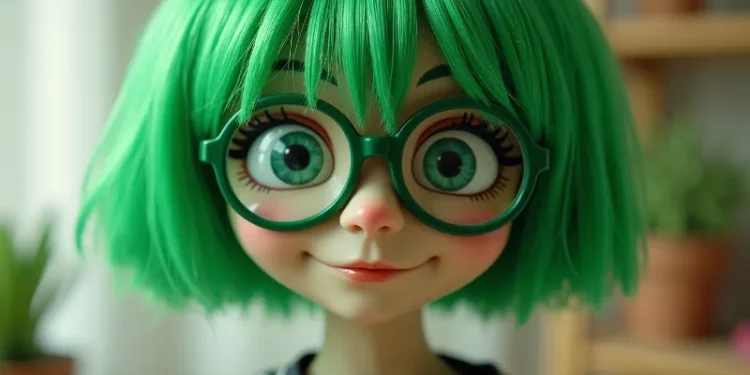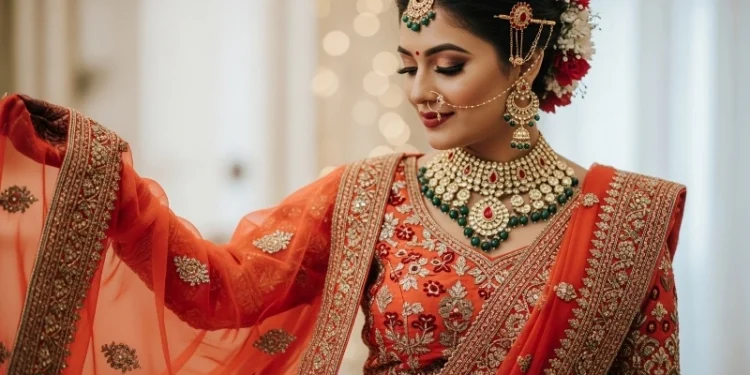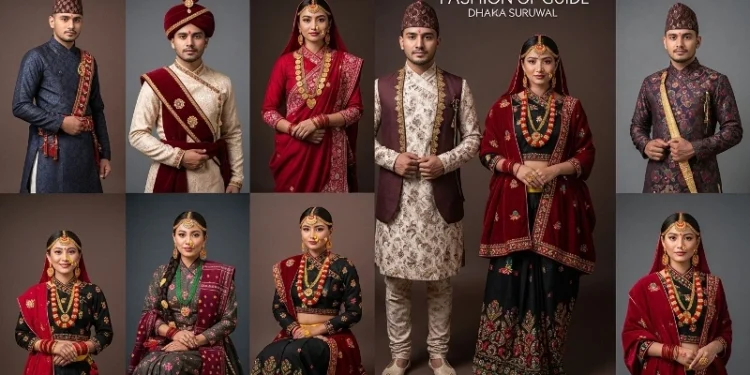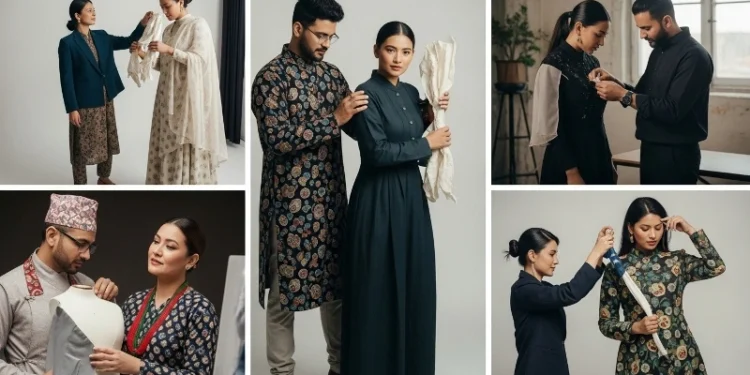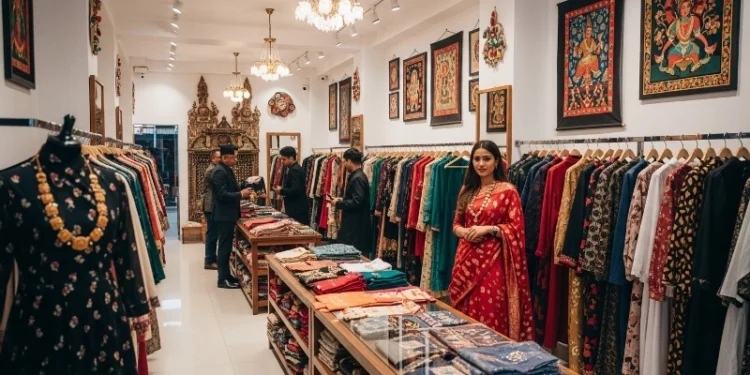The saree is one of the most elegant and timeless garments in South Asian fashion, and it holds a special place in Nepali culture. Worn during festivals, weddings, and special occasions, the saree is versatile and can be styled in numerous ways to reflect tradition, personal taste, and modern trends.

Nepali fashion experts have mastered the art of styling sarees, blending traditional draping techniques with contemporary flair. In this guide, we will explore how to style a saree, providing practical tips from Nepali fashion experts to help you look your best in this beautiful garment.
1.Understanding the Saree: A Traditional Staple
The saree is more than just a piece of fabric; it is a symbol of cultural pride and identity. In Nepal, sarees are worn for many important occasions, including religious ceremonies, weddings, and festivals like Dashain and Tihar.
Traditionally, a saree is made from five to nine yards of fabric, which is draped elegantly around the body. Nepali sarees come in a variety of materials, including silk, cotton, and georgette, each offering a unique texture and style.
The appeal of the saree lies in its ability to be both traditional and contemporary, depending on how it is styled. Nepali women often opt for richly embroidered sarees for formal events, while lighter, more casual versions are worn in everyday life. The versatility of the saree makes it a perfect choice for all kinds of occasions.
2.Choosing the Right Fabric for Your Saree
Selecting the right fabric is one of the most crucial aspects of styling a saree. Nepali fashion experts suggest that your fabric choice should depend on the occasion, the season, and your body type. Here are some commonly used fabrics and their unique properties:
Silk: Silk sarees are a popular choice for weddings and formal events in Nepal. They are known for their luxurious texture and are often adorned with intricate embroidery or zari work. Silk sarees drape well and exude elegance, making them ideal for grand occasions.
Cotton: Cotton sarees are lightweight, breathable, and perfect for casual wear or daytime events. They are comfortable to wear, especially during the summer months, and can be styled with minimal accessories for a simple yet sophisticated look.
Georgette and Chiffon: These fabrics are flowy and lightweight, making them easy to drape. Georgette and chiffon sarees are ideal for parties or events where you want a glamorous, modern look. They also suit women with a petite frame, as the fabric hugs the body without adding bulk.
When choosing a fabric, consider the comfort and the event you’re attending. Nepali fashion experts also advise considering the weather, as heavy fabrics like silk may not be suitable for warmer months.
3.Classic Draping Styles Every Nepali Woman Should Know
There are numerous ways to drape a saree, and each style can give you a completely different look. Here are some of the most popular saree draping styles commonly used in Nepal:
Nivi Style: This is the most common way to drape a saree and is popular not just in Nepal but across the Indian subcontinent. The saree is wrapped around the waist, with pleats neatly tucked in front, and the pallu (the loose end of the saree) draped over the shoulder. This style works well for both casual and formal occasions.
Bengali Draping: The Bengali draping style is distinguished by its wide pleats and the way the pallu is draped over both shoulders. This style gives the saree a more traditional and dramatic appearance and is ideal for cultural events or festivals.
Maharashtrian Style: The Maharashtrian style of draping a saree is known for its unique pleating and the way the saree is worn like a dhoti. This style adds a regal touch and is perfect for festive occasions, especially if you want to make a statement.
Modern Pleated Style: For a contemporary look, many women opt for a sleek, pleated style. In this version, the saree is pleated tightly and draped in a way that highlights the silhouette, giving a modern and chic look. This style works well for evening events or formal functions.
Nepali fashion experts emphasize the importance of mastering the basics of draping before experimenting with more complex styles. Practice makes perfect, and once you’re comfortable with the classic styles, you can easily modify them to suit your taste.
4.Choosing the Perfect Blouse for Your Saree
The blouse you choose can make or break your saree look. In Nepal, fashion experts pay special attention to designing the perfect blouse that complements the saree. Here are some tips for choosing the right blouse:
Classic Blouse: A classic, shortsleeved blouse with a simple round or Vneckline is a timeless choice. This style pairs well with traditional sarees and can be embellished with embroidery or sequins for a festive look.
Backless or Halter Neck Blouse: For a more modern and daring look, a backless or halter neck blouse is a great choice. These styles work particularly well with chiffon or georgette sarees and add a touch of glamour to your ensemble.
FullSleeved Blouse: If you’re looking for a more conservative or winterappropriate option, fullsleeved blouses are becoming increasingly popular. These blouses add elegance and can feature lace or sheer fabrics for a trendy look.
High Neck Blouse: High neck blouses are sophisticated and pair beautifully with both traditional and modern sarees. This style offers a regal touch and is perfect for formal events or weddings.
Nepali designers often play with different blouse designs to create unique and eyecatching looks. When choosing a blouse, consider the saree’s fabric, color, and the occasion you’ll be wearing it to.
5.Accessorizing Your Saree: Jewelry and Beyond
No saree look is complete without the right accessories. Nepali fashion experts suggest keeping the balance between the saree and jewelry, so they complement each other without overpowering your look. Here are some accessory tips to enhance your saree styling:
Traditional Gold Jewelry: In Nepal, gold jewelry is often worn with sarees during weddings and festivals. A Tilhari (a traditional necklace), Pote (green beads), and large earrings are common accessories. These add a traditional touch and enhance the overall elegance of the saree.
Statement Necklace: For a modern look, opt for a statement necklace that contrasts with your saree. Chunky necklaces or chokers can add a bold element to a plain saree, drawing attention to your neckline and blouse.
Bangles and Bracelets: Bangles are an essential part of saree styling, especially during festivals and weddings. You can choose gold, silver, or colorful bangles that match your saree. Nepali women often stack multiple bangles for a more festive appearance.
Footwear: Your choice of footwear matters when styling a saree. Fashion experts recommend wearing heels to elevate your saree look and create a more graceful silhouette. Heeled sandals, wedges, or stilettos are popular choices.
Bindi and Hair Accessories: A small bindi on the forehead completes the traditional look. Hair accessories, like floral garlands or jeweled hairpins, are also popular choices to complement saree styles for weddings and special occasions.
6.Playing with Colors and Patterns
Color and patterns play a crucial role in how a saree looks. Nepali fashion experts suggest choosing colors that complement your skin tone and patterns that suit the occasion. Here are some tips on selecting the perfect saree color and pattern:
Bold Colors for Weddings: Bright reds, maroons, and golds are popular choices for weddings and religious ceremonies. These colors are seen as auspicious in Nepali culture and make the wearer stand out during important events.
Pastels for Day Events: For daytime events, lighter colors like pastel pinks, blues, and greens are ideal. These shades are soft and subtle, creating a fresh and elegant look.
Printed Sarees for Casual Occasions: Printed sarees with floral or geometric designs are great for casual or semiformal events. These sarees are versatile and can be paired with simple accessories for a chic look.
Embroidered Sarees for Festivals: Heavily embroidered sarees with zari or beadwork are a staple during festivals. These sarees add a touch of tradition and grandeur, perfect for celebrations like Dashain and Tihar.
Nepali fashion designers often experiment with bold patterns and vibrant colors to create unique saree collections. When choosing your saree, make sure the color and pattern match the occasion and complement your personal style.
7.How to Maintain and Care for Your Saree
A saree is an investment, and taking care of it ensures that it lasts for years. Nepali fashion experts provide valuable tips on maintaining and storing sarees:
Dry Clean Silk Sarees: Silk sarees are delicate and should always be dry cleaned to maintain their sheen and prevent damage. Avoid washing silk sarees at home, as water can weaken the fabric.
Store Properly: When storing your sarees, fold them neatly and place them in a breathable cotton bag. For heavily embroidered sarees, it’s recommended to wrap them in muslin cloth to prevent the embellishments from getting damaged.
Iron Carefully: Use a low heat setting when ironing sarees, especially delicate fabrics like silk and chiffon. Place a cloth over the saree while ironing to prevent direct heat contact and avoid damaging the fabric.
Rotate Folding Rotate Folding: If you store sarees for a long time, especially silk and embroidered sarees, it’s important to refold them every few months. This prevents permanent creases and ensures that the fabric maintains its quality over time.
Avoid Direct Sunlight: Prolonged exposure to sunlight can fade the colors of your saree. When drying sarees, especially after washing, avoid direct sunlight. Opt for a shaded area where the fabric can air dry gently.
By following these care tips, you can ensure that your sarees stay in pristine condition, ready to wear for many occasions.
8.Experimenting with Contemporary Saree Styles
While traditional saree draping is timeless, many modern women are experimenting with contemporary styles. Nepali fashion experts encourage women to try out different draping techniques and styles that break away from tradition but still maintain the grace of the saree. Here are some trendy contemporary styles:
Belted Saree: Adding a belt over the saree is a modern trend that accentuates the waist and gives a structured look. You can use a metallic or fabric belt that complements the color of your saree. This style is perfect for both formal events and cocktail parties, giving a fusion of traditional and modern fashion.
Pant Style Saree: Instead of draping the saree around a traditional petticoat, many women now pair it with trousers or leggings. This creates a modern, sleek look and allows for easier movement, making it ideal for events where you want to combine comfort with style.
Cape with Saree: For a redcarpetready look, you can wear a cape over your saree. This contemporary style adds a dramatic flair and is perfect for glamorous events or evening parties. The cape can be sheer or embroidered, depending on the occasion.
Jacket with Saree: Another modern twist is to pair your saree with a jacket instead of a traditional blouse. A long, tailored jacket can add sophistication, while shorter, fitted jackets give a more casual and edgy vibe. This style is perfect for colder weather or formal events.
These contemporary styling ideas allow you to experiment and make your saree look fresh and unique. Nepali fashion designers are increasingly incorporating these modern elements into their collections, giving women more ways to express their personal style.
9.Styling Sarees for Different Body Types
Nepali fashion experts emphasize the importance of choosing saree styles that complement different body types. Here are some tips to help you style a saree according to your body shape:
Petite Frame: For petite women, lighter fabrics like chiffon, georgette, or crepe work best as they don’t add bulk. Opt for sarees with minimal embellishments and small prints. Pleating the saree tightly and draping it close to the body creates a longer, leaner silhouette.
Curvy Figures: Curvy women can choose sarees with mediumweight fabrics like silk or satin, as they drape beautifully over the body. Sarees with larger patterns, darker colors, or vertical designs help to create a balanced and flattering look. A wellfitted blouse with a defined neckline can enhance the overall silhouette.
Tall and Slim: Tall and slim women can experiment with bold patterns, heavy borders, and a wide range of fabrics. Silk sarees with large prints or heavy embroidery work well. You can also drape the saree loosely to add volume and texture to the overall look.
PearShaped Body: Women with a pearshaped body can opt for sarees with lighter fabrics on the bottom and heavier embellishments or designs on the pallu or blouse. This helps balance the proportions and draws attention to the upper part of the body.
By understanding your body type and choosing the right fabric, draping style, and blouse design, you can enhance your appearance and feel confident in your saree.
10.Saree Styling for Different Occasions
Sarees are suitable for a variety of occasions, from formal events to casual gatherings. Here’s how you can style a saree for different types of events, as recommended by Nepali fashion experts:
Weddings: Weddings in Nepal are grand affairs, and the saree is the perfect attire for such occasions. Opt for silk or heavily embroidered sarees in traditional colors like red, maroon, or gold. Pair the saree with heavy jewelry, including gold necklaces, bangles, and earrings, to complete the look.
Festivals: For festivals like Dashain, Tihar, and Teej, choose vibrant sarees with colorful patterns and light embroidery. Cotton, silkblend, or georgette sarees are great options. Keep the jewelry simple but traditional, with a Tilhari, bangles, and a small bindi.
Corporate Events: For formal corporate events, it’s best to choose sarees in neutral or pastel tones. Avoid heavy embellishments and stick to minimalistic designs. Pair your saree with a structured blouse and simple jewelry, such as stud earrings and a sleek watch.
Parties and Celebrations: For parties or cocktail events, go for a contemporary look by choosing a saree in a light fabric like chiffon or georgette. Opt for a bold color like black, royal blue, or emerald green. Pair it with a statement blouse, such as a halter neck or a backless design, and accessorize with a statement necklace or earrings.
Casual Day Out: For casual outings, a cotton or printed saree works well. Pair it with a simple blouse, and keep the accessories minimal. A lightweight saree is easy to wear and will keep you comfortable throughout the day.
By tailoring your saree styling to the event, you can ensure that you look both appropriate and stylish.
11.FAQs
1. What is the most popular way to drape a saree in Nepal?
The most popular way to drape a saree in Nepal is the Nivi style, which involves wrapping the saree around the waist with pleats in the front and the pallu draped over the shoulder.
2. What is the best fabric for a saree?
The best fabric depends on the occasion and comfort. Silk is ideal for formal events, while cotton and georgette work well for casual or semiformal settings.
3. How can I make my saree look more modern?
To give your saree a modern touch, you can experiment with different blouse designs, such as halter neck or backless styles, and accessorize with a belt or statement jewelry.
4. What accessories should I wear with a saree?
Traditional gold jewelry, a bindi, bangles, and statement necklaces are commonly worn with sarees. Footwear such as heeled sandals or wedges completes the look.
5. How do I choose the right blouse for my saree?
The right blouse depends on the saree fabric and style. For a traditional look, go with a shortsleeved blouse. For a modern twist, try a backless or halter neck blouse.
6. Can I wear a saree to a corporate event?
Yes, sarees are suitable for corporate events. Choose a neutral or pastelcolored saree with minimal embroidery, and pair it with simple jewelry for a professional look.
7. How do I drape a saree for a wedding?
For weddings, opt for a silk saree in vibrant colors like red or gold. Drape the saree in the traditional Nivi style and accessorize with heavy gold jewelry.
8. What saree style works best for petite women?
For petite women, lightweight fabrics like chiffon and georgette are ideal, as they drape well without adding bulk. Opt for small prints and tight pleats to create a longer silhouette.
9. How do I maintain my sarees?
Sarees should be drycleaned (especially silk), stored in breathable cotton bags, and refolded periodically to avoid creases. Avoid direct sunlight to prevent fading.
10. Can sarees be styled with modern clothing?
Yes, sarees can be styled with modern clothing such as jackets, capes, or belts. This adds a contemporary twist while maintaining the traditional elegance of the saree.
12.Conclusion
Styling a saree offers endless possibilities, whether you prefer a traditional look or want to experiment with contemporary fashion. By choosing the right fabric, draping style, blouse, and accessories, you can elevate your saree look to suit any occasion.
The timeless beauty of the saree, combined with modern fashion trends, ensures that it remains a beloved garment in Nepali culture and beyond.
Nepali fashion experts have mastered the art of saree styling, and by following their tips, you can confidently wear a saree in a way that reflects both tradition and personal style. Whether you’re attending a wedding, celebrating a festival, or going to a casual event, there’s a perfect saree style for every occasion.
